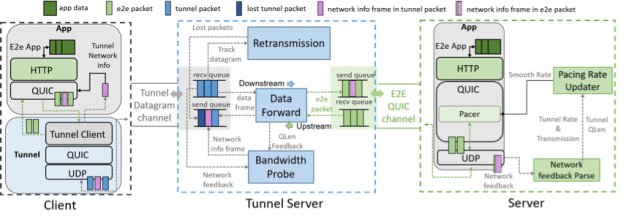Interactive applications, such as live video streaming and cloud gaming, have extremely high demands for low end-to-end transmission latency. The high dynamism and heterogeneity of mobile networks make traditional network transmission mechanisms insufficient for the latency requirements of interactive applications.
Professor Zhenyu Li from Network Technology Research Center at the Institute of Computing Technology, Chinese Academy of Sciences led an international collaboration team to conduct research on low-latency network transmission. This research involves coordinating transmission at two levels. Firstly, the team developed a multipath coordinating transmission protocol. Mobile devices often have access to multiple networks, such as Wi-Fi and cellular, therefore multiple transmission paths are available. A significant challenge with multipath transmission is the variance in path quality, which can constrain latency to that of the slowest path. To address this, the team introduced a QoE-aware multipath transmission scheduling mechanism. This mechanism dynamically adjusts packet allocation and sending strategies based on the QoE requirements of the application to achieve high throughput and low latency with minimal redundant transmissions. Moreover, they designed a machine learning-based congestion control mechanism for multipath transmission to identify bottleneck links in real-time and select the optimal congestion control algorithm, further reducing latency. Additionally, they designed a machine learning-based congestion control mechanism for multipath transmission to identify bottleneck links in real-time and select the optimal congestion control algorithm, further reducing latency.
Second, the team proposed an end-edge-cloud coordinating transmission mechanism. The bottleneck in mobile internet transmission often occurs in the "last mile" near the clients, which severely limits the overall end-to-end transmission speed. Traditional mechanisms suffer from long congestion control loop and slow packet loss recovery, which exacerbate network latency. The newly proposed mechanism offloads congestion control from the server side to edge nodes closer to the client, significantly shortening the congestion control loop and accelerating packet loss recovery. This approach allows the servers to accurately calculate the sending rate without traditional congestion control algorithms. Meanwhile, this study has been applied in internet companies, serving hundreds of millions of users and significantly reducing transmission latency, meeting the needs of services such as live video streaming.
The above work has been continuously published in top international conferences in the field of computer networks, including NSDI 2024 (USENIX Symposium on Networked Systems Design and Implementation), MobiCom 2024 (Annual International Conference On Mobile Computing And Networking), and ICNP 2023 (IEEE International Conference on Network Protocols). The work was supported by the National Key R&D Program, the Beijing Natural Science Foundation, and the International Partnership Program of the Chinese Academy of Sciences.
Paper link:
ICNP[https://ieeexplore.ieee.org/abstract/document/10355608]
NSDI[https://www.usenix.org/conference/nsdi24/presentation/zhang-jiaxing]
downloadFile

